The Full Strawberry Moon, Maximum Mercury after Sunset, Both Gas Giant Planets Enter Evening Skies, and Comet PanSTARRS Passes Dubhe!
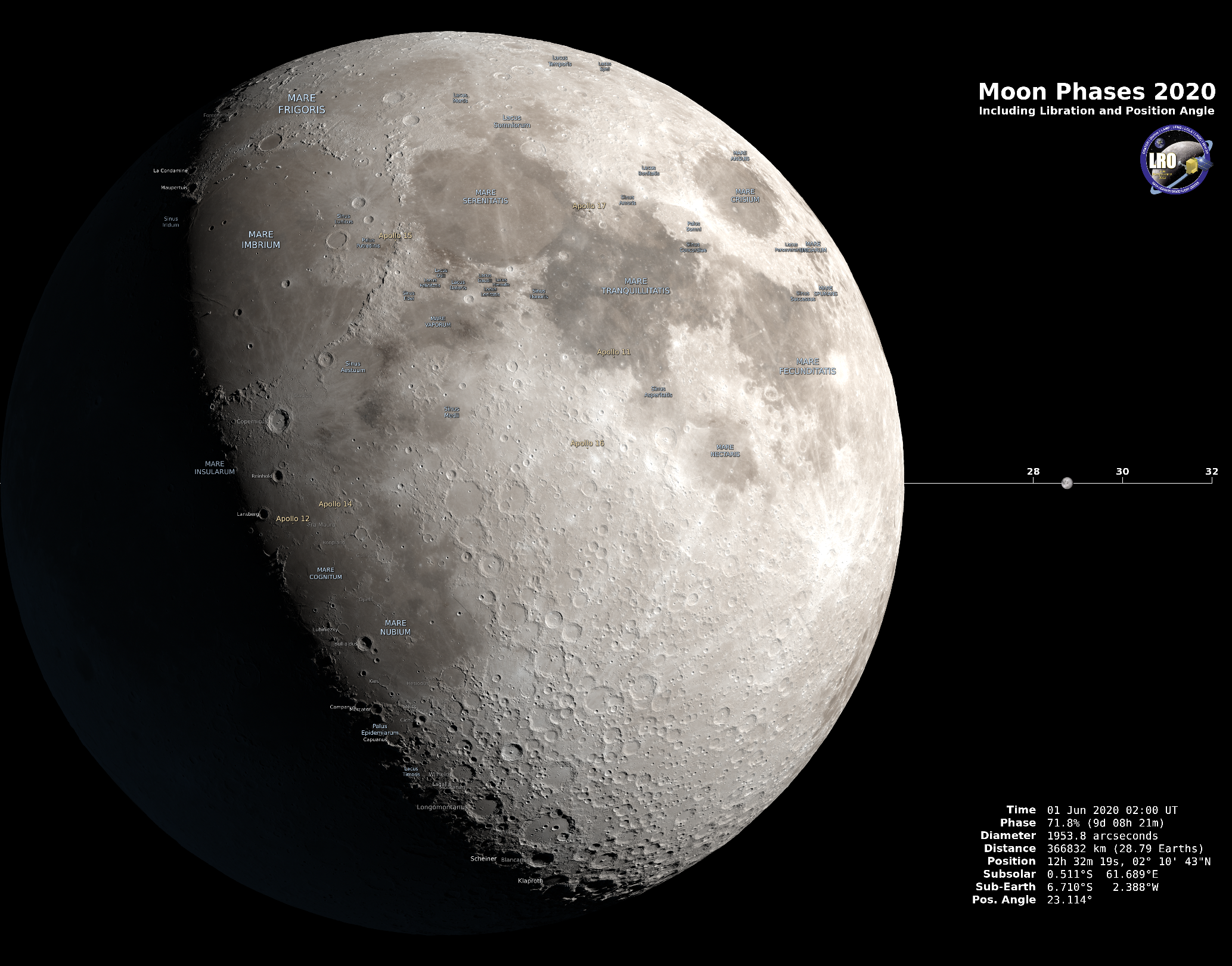
NASA’s Moon Phase and Libration visualization tool will generate hour-by-hour annotated views of the moon, such as this one for 10 pm EDT on May 31, 2020. You can find more at https://svs.gsfc.nasa.gov/4768. There is also an option to generate south up views for use at your telescope eyepiece.
Hello, Moon Lovers!
Here are your Astronomy Skylights for the week of May 31st, 2020 by Chris Vaughan. Feel free to pass this along to your friends and send me your comments, questions, and suggested topics. You can also follow me on Twitter as @astrogeoguy! Unless otherwise noted, all times are expressed in Eastern Time.
I can bring my Digital Starlab portable inflatable planetarium to your school or other daytime or evening event, or teach a session online. Contact me through AstroGeo.ca, and we’ll tour the Universe or the Earth’s interior together!
The waxing moon will offer evening views all over the world this week as it moves from first quarter to full, and beyond. Comet SWAN can be seen with binoculars, especially if you live at a southerly latitude. A dimmer comet named PanSTARRS will enter the Big Dipper’s bowl during evenings near Dubhe – making it easy to locate. Jupiter and Saturn will both begin to rise before midnight, Mars will shine brighter in the pre-dawn, and Mercury will reach peak visibility, alone in the west after sunset, on Wednesday. Here are your Skylights!
Bright Comets Update
A comet named c/2020 F8 (SWAN) has become bright enough to see with binoculars and backyard telescopes. (It’s about magnitude 5.5 and fading.) Its orbit is keeping it too low in the sky, and too close to the sun, for easy viewing by people living at mid-northerly latitudes. But folks at more southerly latitudes, or in the Southern Hemisphere, are getting reasonable views of it. In binoculars and backyard telescopes, the comet should look like a greenish fuzzy patch with a faint narrow tail that extends to the upper right (or celestial north).
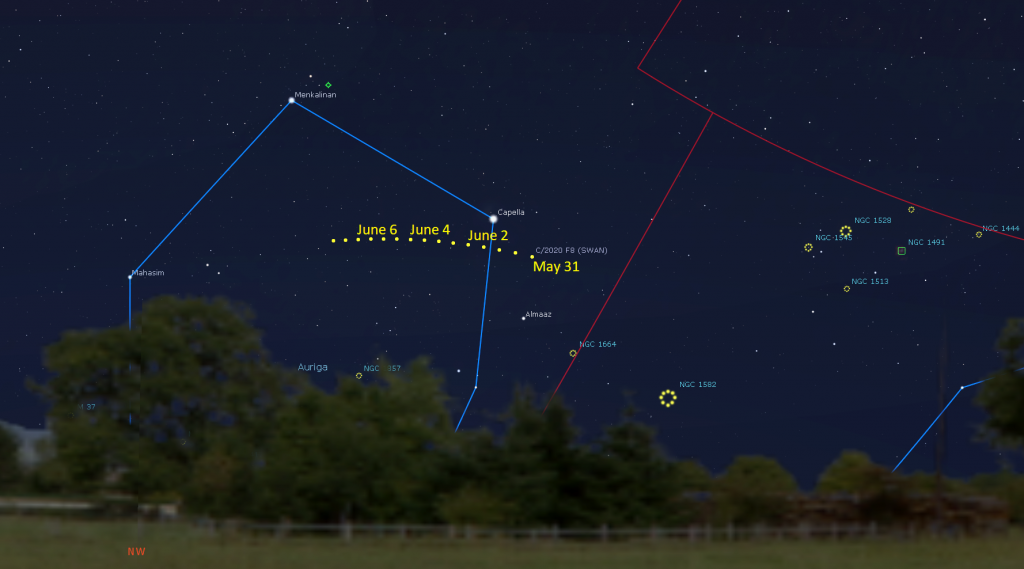
This week, look for Comet SWAN sitting low in the northwestern sky after the sky darkens. This week its orbit will take it east through Auriga (the Charioteer) and closely past the very bright star Capella on Monday and Tuesday evening.
Another comet named c/2017 T2 (PanSTARRS) is bright enough to see in backyard telescopes, especially if you have a dark location. (It’s magnitude 9.0 and fading.) This week, the comet is going to fly into the Big Dipper, which is parked overhead during the evening at this time of year. On Sunday night, May 31, the comet will be positioned three finger widths to the lower right of the bright star Dubhe. That star marks the outer rim of the dipper’s bowl. It’s high in the northwestern sky. On Wednesday and Thursday, the comet will pass less than a finger’s width (or one degree, or two full moon diameters) to the upper right of Dubhe, and then it will enter the dipper’s bowl.

The Moon
The moon will spend this week shining brightly in the evening sky all over the world as its orbit around Earth carries it through the zodiac constellations. Over the same period, the moon will wax from slightly more than half-illuminated tonight (Sunday), reach full on Friday, and then wane to a gibbous phase on the coming weekend.
This part of the lunar month is especially good (and convenient) for viewing the moon – with unaided eyes, through binoculars, and in telescopes of any size. Along the pole to pole terminator line that divides the lit and dark hemispheres, the sun is casting long, deep black shadows from every crater rim, mountain, bump and ridge. The highlighted areas shift across the moon’s disk from night to night, making it worth a look every night.
Early in the week, the moon will rise in late afternoon. If you want to improve your view of the moon during daylight, try rotating a polarized filter on your eyepiece – or wear 3D glasses from the movies and rotate your head with respect to the telescope’s main tube until the sky darkens.
On Sunday night, the dark hemisphere of the moon will point towards the nearby bright, white star Porrima in Virgo (the Maiden). That star splits into a nice double star when viewed through your telescope. On Monday, the moon will hop east to sit north of the even brighter star Spica. On Wednesday night, the nearly full moon will land within the dim stars of the Scales of Libra. And on Thursday night, look for the 99% full moon sitting a palm’s width above (or 7° to the celestial northwest of) the bright reddish star Antares, the heart of Scorpius, the scorpion.
The moon will reach its full phase at 3:12 pm EDT (or 19:12 Greenwich Mean Time) on Friday. The June full moon, colloquially known as the Strawberry Moon, Mead Moon, Rose Moon, or Hot Moon, always shines in or near the stars of southern Ophiuchus (the Serpent-Bearer). The indigenous Ojibwe people of the Great Lakes region call this moon Ode’miin Giizis, the Strawberry Moon. (Their July moon will be the Raspberry Moon.) The Cree Nation of central Canada calls the June full moon Opiniyawiwipisim, the Egg Laying Moon (referring to the activities of wild water-fowl). The Mohawks call it Ohiarí:Ha, the Fruits are Small Moon.
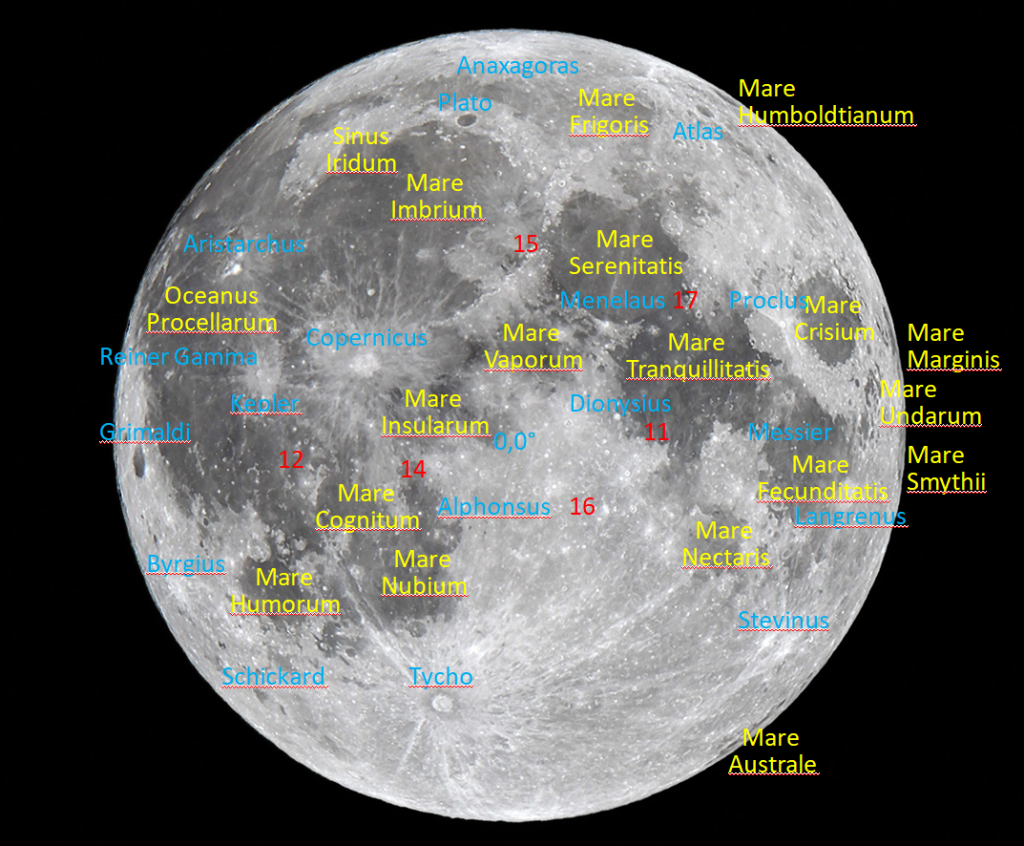
Because the moon reaches its full phase when it is opposite the sun in the sky, full moons always rise in the east as the sun is setting, and set in the west at sunrise. Since sunlight is hitting the moon vertically at that time, no shadows are produced by terrain on the full moon; all of the variations in brightness you will see arise from differences in the reflectivity, or albedo, of the lunar surface rocks.
The dark areas, or lunar maria, are ancient basins carved by huge objects that struck the young moon, and were much later flooded by dark, iron-rich basalt that upwelled from the warm interior of the moon. Several maria link together to form a curving chain across the northern half of the moon’s near-side. Mare Tranquillitatis, where humankind first walked upon the moon, is the large, round mare in the centre of the chain. It’s not hard to see that this mare is darker and bluer than the others, due to enrichment in the mineral titanium. Apollo 11 landed near its lower left (southwestern) edge.
The rest of the moon, the highlands, is brighter and whiter, owing to the reflectivity of the crystal structure in the anorthosite rocks. Without wind or water to erase them, the abundant craters there tell the story of the moon’s bombardment by left-over bits of the forming solar system over time.
This full moon will be accompanied by a penumbral lunar eclipse between 17:46 and 21:04 GMT. At greatest eclipse at 19:25 GMT, the moon will have only dipped about halfway into the Earth’s northern penumbral shadow, barely darkening the moon’s southern limb. The entire eclipse will be visible from most of Africa, the Middle East, central Asia, and most of Australia. Observers in the Americas will not see any portion of the eclipse – except along the eastern edge of South America, where the moon will rise as the eclipse is ending.
For the coming weekend, the waning gibbous moon will rise close to midnight and will sit near the Teapot-shaped stars of Sagittarius (the Archer).
The Planets
Venus will swing past the sun at inferior conjunction on Wednesday. Later in June, the bright planet will return to visibility in the eastern pre-dawn sky.
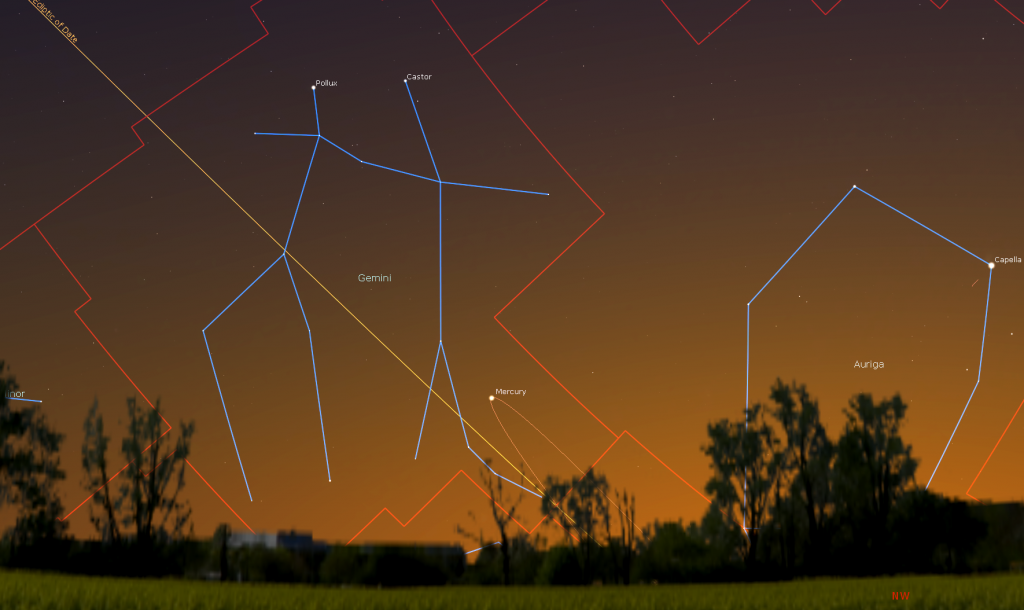
Mercury will be nicely placed for easy viewing after sunset this week. You can spot its bright little dot with your unaided eyes or binoculars, and see it magnified in a backyard telescope. Ensure that the sun has completely disappeared below the horizon before pointing binoculars and telescopes anywhere close to the western horizon. As the western sky darkens, the swift little planet will emerge from the twilight. If you have a low, unobstructed view of the northwestern horizon, Mercury should fairly easy to see between about 9:15 pm almost 10 pm in your local time zone, dropping lower in that interval.
Seeing Mercury will be easiest on Wednesday and Thursday evening, when the planet will reach its widest angular separation from the sun – meaning that it will set in a darker sky. When viewed in a backyard telescope, Mercury will show a waning, less than half-illuminated disk. If you want to see the planet’s disk, aim your telescope at it as soon as you can pick it out of the darkening sky. When it is higher in the sky you’ll be viewing the planet more clearly – through less of Earth’s distorting atmosphere.
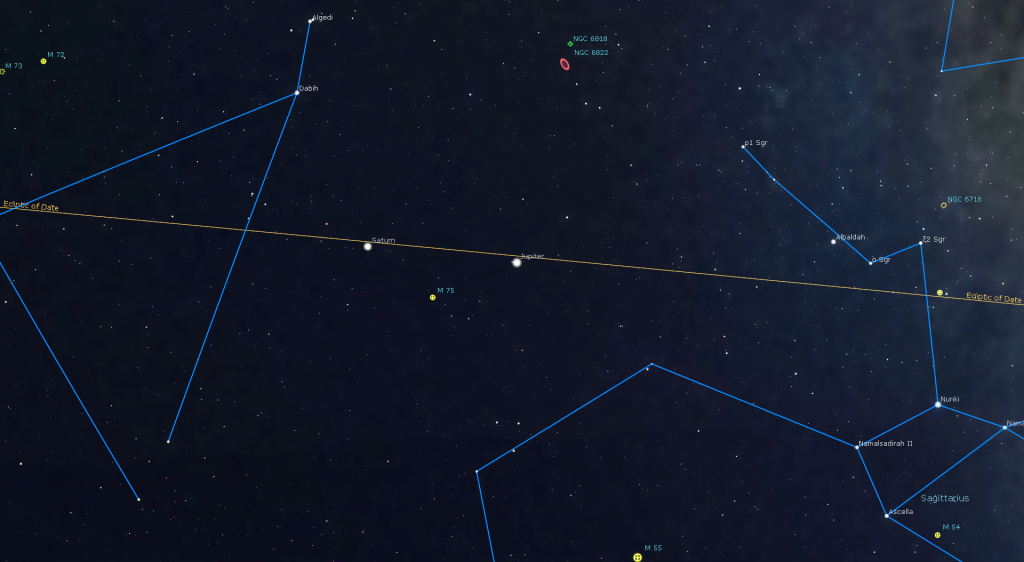
By the end of this week, both Jupiter and Saturn will be rising shortly before midnight! Hooray! Those two gas giants will be only a slim palm’s width apart in the sky, with Saturn to the left (east) of Jupiter. Saturn will be rising and setting only 15 minutes after Jupiter. In the wee hours of the night, very bright, white Jupiter might catch your eye through a southerly window. By dawn you’ll find it sitting less than three fist diameters above the southern horizon before it fades into the brightening sky. Dimmer, yellowish Saturn will fade from sight before Jupiter does.
This week, the globular star cluster named Messier 75 (or NGC 6864) will be positioned below and between Jupiter and Saturn. In the dark, moonless sky before morning twilight begins, the magnitude 9.2 cluster should be visible in binoculars and backyard telescopes as a small, fuzzy patch located approximately two finger widths below (or 1.5 degrees to the celestial south of) the two much brighter planets. Every morning, the planets will shift a little bit to the right (west) compared to the cluster. So it will be closer to Saturn than Jupiter before long.
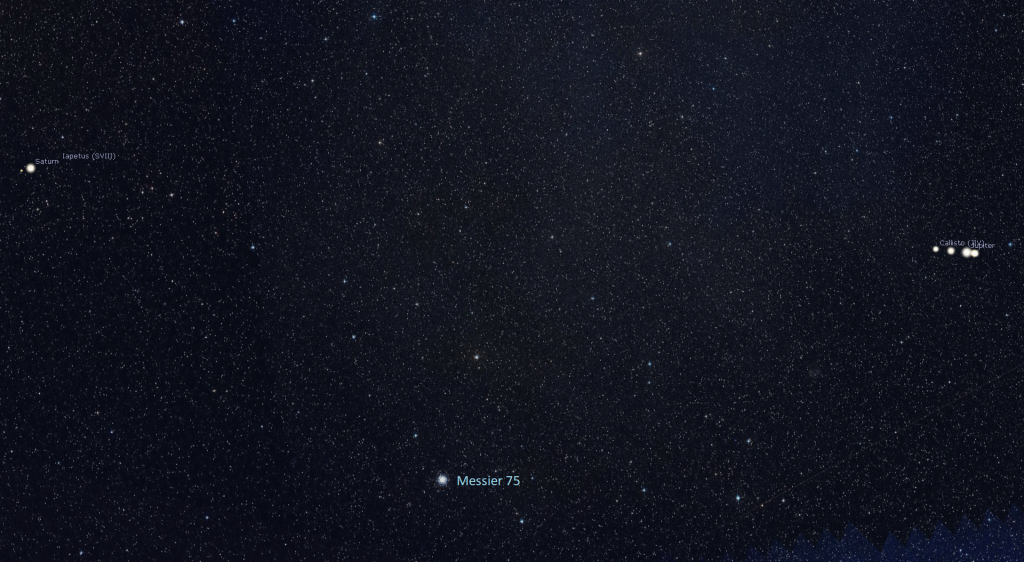
In the Eastern Time zone, Jupiter’s Great Red Spot will be crossing the planet’s disk before dawn on Monday morning, Wednesday morning, and Saturday morning. It will also be visible on Wednesday after midnight. From time to time, the small round black shadows cast by Jupiter’s four large Galilean moons become visible in amateur telescopes as they cross (or transit) the planet’s disk. On Sunday morning, June 7, observers in the Americas can see Io’s shadow in the hour before 1:45 am EDT.
Dust off your telescope! Even a small telescope will show Saturn’s rings and several of its brighter moons – especially its largest moon, Titan! Because Saturn’s axis of rotation is tipped about 27° from vertical (a bit more than Earth’s axis), we can see the top surface of its rings, and its moons can arrange themselves above, below, or to either side of the planet. During this week, Titan will migrate counter-clockwise around Saturn, moving from the left of Saturn tonight (Sunday) to the right of the planet next Sunday. (Remember that your telescope will flip the view around.)

Reddish Mars has been speeding eastward along the ecliptic, leaving the bright gas giants planets far behind. This week, Mars will be crossing Aquarius (the Water-Bearer). It will be rising after 2 am local time, and will remaining visible until dawn, when it will be found about two fist diameters above the southeastern horizon. Mars is steadily increasing in disk size and brightness because Earth is travelling towards it. Mars is going to pass close to much dimmer Neptune next week.
Bright Stars Tour
Even with an evening moon this week, the brighter stars will remain visible to your unaided eyes. Here’s a rundown of the brightest ones. (I’ve put their bright star rankings in parentheses – not counting the sun.)
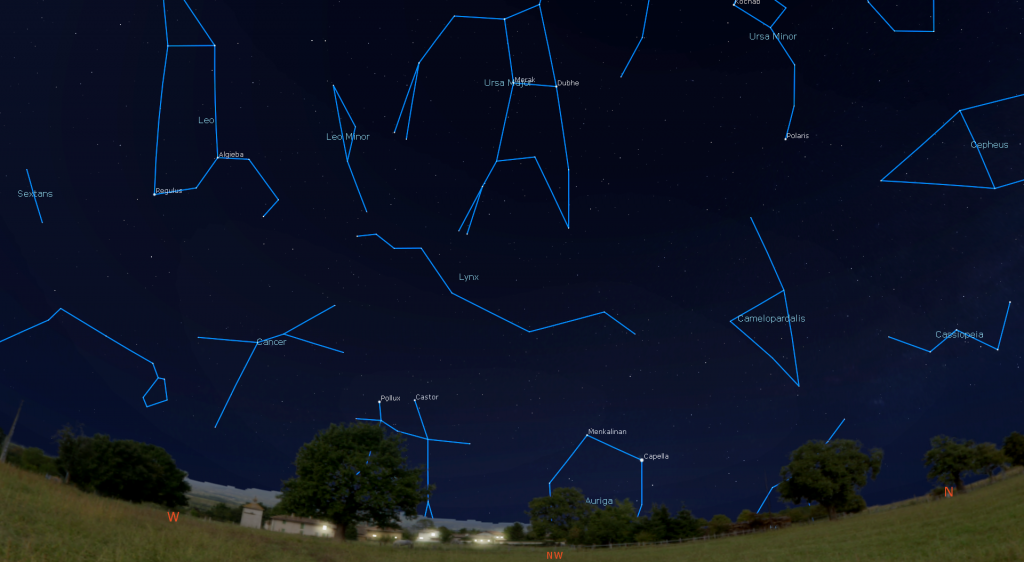
Facing west right after sunset, look low in the sky for the bright, yellowish star Capella (6th) in Auriga (the Charioteer). A little higher, and to the east (left), you’ll find the almost matched pair of stars golden Castor (24th) on the right and warm-white Pollux (17th) on the left – in Gemini (the Twins). Well to the upper left of the twins, you’ll find bright, white Regulus (21st), the heart of Leo (the Lion). As the sky darkens, look directly overhead for the seven medium-bright, white stars of the Big Dipper. Its handle will be pointed upwards.
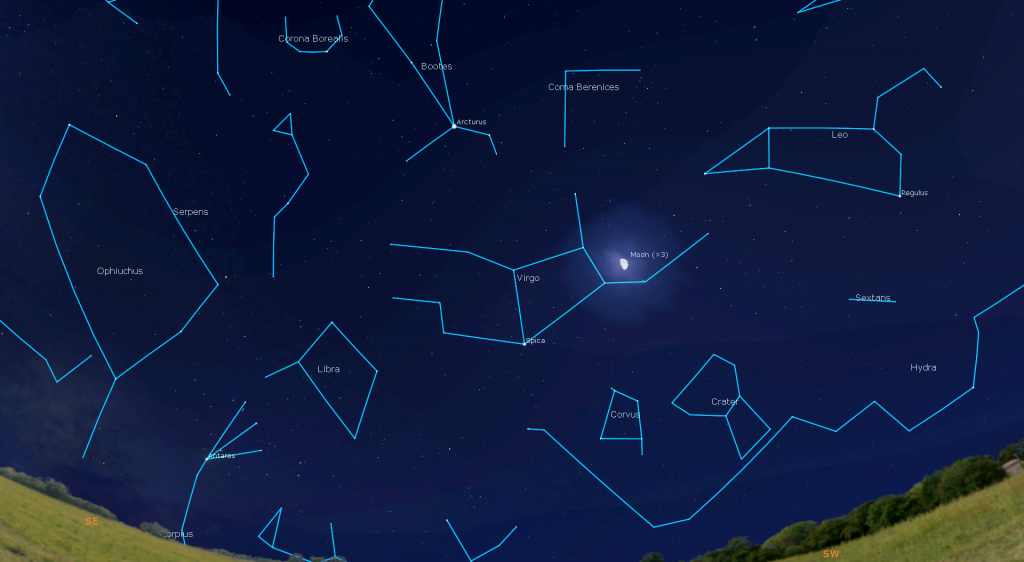
Swing around and look south and east. Reddish Antares (15th), the baleful eye of Scorpius (the Scorpion) will be sitting low over the southeastern horizon. The bright white star high above the southern horizon is Spica (16th) in Virgo (the Maiden). And much higher you’ll find yellow-orange Arcturus (4th), the brightest star in Boötes (the Herdsman).
Climbing the eastern sky is Vega (5th), in Lyra (the Harp). To Vega’s lower left (or the celestial northeast) is another bright star named Deneb (19th). Just clearing the horizon below Vega, you should find Altair (12th), the brightest star in Aquila (the Eagle). The three hot, white stars Vega, Deneb, and Altair mark the corners of the Summer Triangle asterism. And that tells us that summer is about to arrive in the Northern hemisphere!

Public Astro-Themed Events
Due to the COVID-19 virus, in-person public star parties and lectures have been cancelled or postponed for the moment. Here are some Internet-based astro-themed activities.
Our David Dunlap Observatory Saturday night events may be cancelled, but we’re still pleased to offer the next best thing – a free online talk by Dr. Rupinder Brar of Ontario Tech University. Tune in to the RASC Toronto Centre’s YouTube channel at 7:30 pm EDT on Saturday, June 6 to see his talk Einstein’s Great Prediction: The Discovery of Gravitational Waves. More information is here.
Many astronomers are running broadcasts of the views through cameras attached to their telescopes while they describe the item and take questions. A search for the terms “star party” on YouTube and FaceBook should let you find live or pre-recorded sessions.
The Canadian organization Discover the Universe is offering astronomy broadcasts via their website here, and their YouTube channel here.
On many evenings, the University of Toronto’s Dunlap Institute is delivering live broadcasts. The streams can be watched live, or later on their YouTube channel here.
The Perimeter Institute in Waterloo, Ontario has a library of videos from their past public lectures. Their Lectures on Demand page is here.
Keep looking up, and enjoy the sky when you do. I love questions and requests. Send me some!